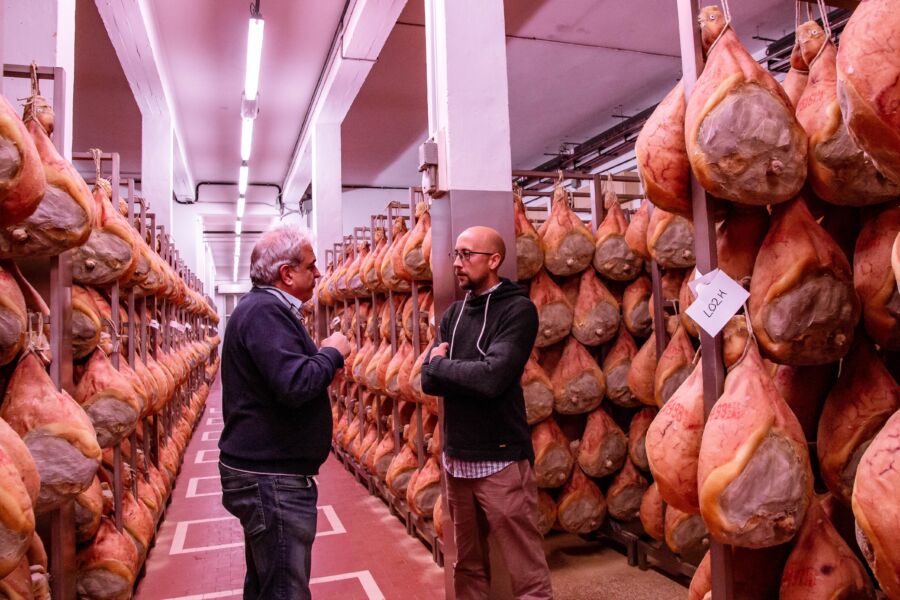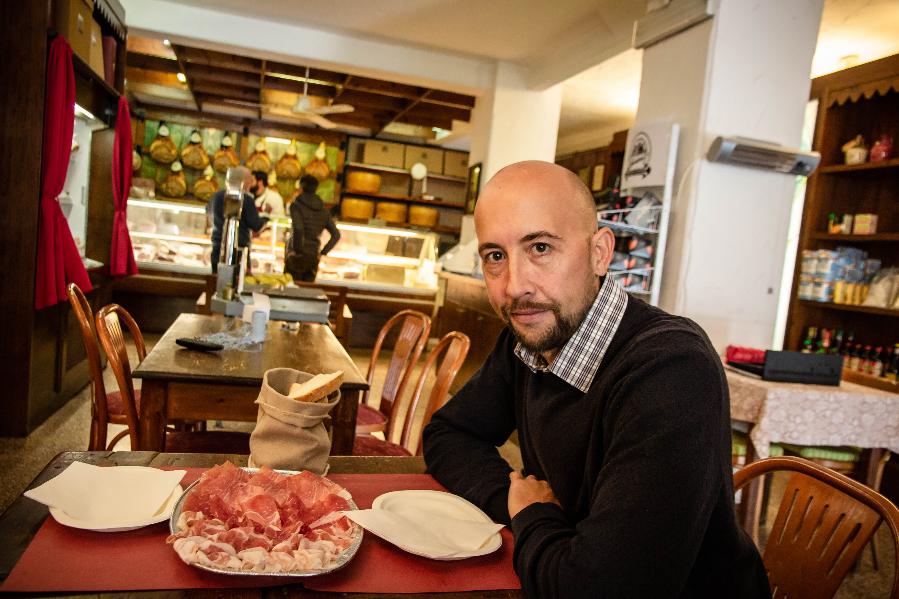Prosciutto di Parma is more than just a delicious cured meat — it’s a product steeped in centuries of tradition, artisanal skill, and careful regulation. You’ve probably noticed that this ham, often featured in gourmet shops or fine dining menus, carries a premium price tag.

The truth is, every slice tells a story — one of patience, precision, and the unique qualities of a specific region in Italy.
Now, I will say I’ve seen ‘cheap’ versions of prosciutto (not Parma, however), and the commercialization of meat in Europe has also meant that many previous standards in Italy have dropped. I’ve witnessed firsthand the sourcing of pigs from other countries, primarily to increase profits at the expense of quality.
The ‘Prosciutto di Parma’ is protected by European regulations, and the passion for the local pig follows through the entire process.
What makes Prosciutto di Parma so renowned, and why does it command such a high price? In this article, I’ll break down the process, explain what makes it special, and share my firsthand experiences from Parma itself.
Prosciutto di Parma
If you’re into high-quality, artisanal foods, Prosciutto di Parma is definitely worth your attention. Whether you’re a curious home cook or a meat-curing enthusiast, understanding this product adds a deeper layer to your enjoyment of it.
This post is for food lovers, culinary explorers, and anyone interested in traditional dry-cured meats. By the end, you’ll have a solid appreciation for the craftsmanship behind Prosciutto di Parma — and why it’s worth every cent.
The Craft Behind Prosciutto: Why It’s So Special
It’s important to know that Prosciutto di Parma isn’t just any cured ham. Only hams produced in a small region around Parma, Italy, using traditional methods, can be called by this name.
The ingredients are surprisingly simple: pork and salt. But what are the processes and conditions required to transform those elements into something world-class? That’s what sets it apart.
Quality pork, careful salting, and long natural drying over months (or even years) result in one of the most refined meats I’ve ever eaten.
What Makes Prosciutto di Parma Unique?

Several factors contribute to the flavor and texture that make Prosciutto di Parma stand out from all other dry-cured hams.
- Specific pig breeds (Landrace and Duroc (cross or pure – must be born/raised in Italy)
- A diet of grains, whey, and regional ingredients
- Natural aging in Parma’s unique climate
- Extended drying time — 12 to 36 months
Only pigs raised in Northern Italy under strict welfare standards are eligible. Their diet — including the whey from Parmigiano Reggiano cheese — contributes to the sweet, nutty character of the meat.
Parma’s climate is equally important. The mix of mountain and coastal air creates a slow-drying environment, eliminating the need for artificial climate control. I’ve seen firsthand how producers simply open or close windows depending on the weather — it’s an old-school but precise way of maintaining balance and natural airflow.
Different Types of Prosciutto/Jamon
While Prosciutto di Parma is one of the most celebrated cured hams in the world, it’s helpful to understand how it compares to other types. That puts its uniqueness in perspective.
The Jamon of Spain is different but very similar in the ways of production, it’s not a Proscuitto, it’s Jamon!
- Prosciutto Crudo: A general term for uncooked Italian dry-cured ham. Prosciutto di Parma is one example, but other regions, such as San Daniele or Serrano.
- Prosciutto Cotto: A cooked ham that is pink, moist, and milder in flavor. It’s not dry-cured.
- Jamon Serrano: Spain’s answer to prosciutto, often saltier and drier, with a slightly tougher texture.
- Jamon Iberico: Made from Iberian pigs fed acorns, this ham is aged even longer and has a rich, nutty flavor.
If you’d like more insight into the artistry behind Parma’s curing traditions, this “Long Road to Prosciutto di Parma” feature by Serious Eats describes cellar environments dense with mountain air, precise humidity control, and the magic of salt, sea air, and time.
When I was in Parma, I tried several producers. What stood out was the sweet, balanced flavor. It’s the kind of cured meat I could eat every day — not too salty, not too fatty, just perfectly refined. Other European varieties I’ve sampled over the years can be delicious, but sometimes overwhelming in richness or saltiness. Parma ham just melts in your mouth and keeps you coming back.
How Prosciutto is Made: A Closer Look at the Process
The journey of Prosciutto di Parma begins with selecting the right pigs — typically Landrace, Duroc, or similar large-framed breeds known for producing meat with balanced muscle and fat.
These pigs are raised under strict guidelines, including a clean diet rich in grains and whey. Their health and environment are monitored to ensure the pork meets the quality expected for PDO certification.
Once slaughtered, the hind legs are carefully trimmed and covered in sea salt. This crucial step draws moisture from the meat and starts the preservation process. A master salatore (salt master) ensures just the right amount of salt is used — too much can overpower the flavor, too little risks spoilage.
After salting, the legs rest in a refrigerated room for about a month. Then, they’re washed and moved into ventilated drying rooms. This early stage of aging is tightly controlled — temperature, humidity, and air movement are constantly monitored.
From there, the prosciutto begins its long, natural drying phase. Over the next 12 to 36 months, the ham slowly loses moisture and gains flavor. The air of the Parma region — alternating between warm and cool — does the work.
When I toured a Parma facility producing over 80,000 legs a year, I noticed how they used open windows to control airflow. If it rained, they shut the windows. If it was dry and cool, they opened them. It was simple, but incredibly effective. This kind of passive climate control only works in a place with the right conditions — and Parma has them.
It’s also worth noting that not every leg makes it through the process. Around 2–3% spoil during aging and must be discarded. That’s part of the cost of maintaining such high standards.
Why Prosciutto is So Expensive
What separates Prosciutto di Parma from other dry-cured hams is the extraordinary dedication to tradition and quality. It’s not just a regional delicacy—it’s a protected designation of origin (PDO) product. That means every leg of ham labeled “Prosciutto di Parma” must be made in the Parma region under a tightly regulated process.
The production process itself takes a long time — at least a year, often two or more. Each ham must be monitored throughout, requiring time, space, and skill. Labor, climate management, and the risk of spoilage all factor into the final cost.
Unlike industrial prosciuttos that are often mass-produced or imported and finished in Italy, Parma ham stays true to tradition. This is what makes dry curing and charcuterie so fascinating — you can taste the difference when care and time are prioritized over efficiency and scale.
In contrast, many prosciuttos you see at the supermarket may use imported pork or faster production methods. They’re not necessarily bad, but they’re not Prosciutto di Parma.
Prosciutto Alternatives Worth Trying
If Prosciutto di Parma isn’t in your weekly grocery budget, or you’re simply looking to explore other cured hams, there are a few excellent alternatives that still offer plenty of flavor and tradition.
- Speck: A dry-cured, lightly smoked ham from Northern Italy. It’s saltier than Parma ham and carries a gentle smokiness that sets it apart. German Speck is also widely available.
- Jamon Serrano: Spain’s everyday dry-cured ham. It has a firmer texture and stronger salt profile. A great entry point into Spanish charcuterie.
- Jamon Iberico de Bellota: A premium Spanish ham made from free-range Iberian pigs fed on acorns. It’s complex, nutty, and incredibly rich — often more expensive than Parma ham.
If you’re curious about other cured ham options that fit your budget or taste preferences, I’ve written a detailed breakdown of the best prosciutto substitutes. Some are better for cooking, while others are perfect for platters and snacking.
When tasting across regions, I’ve found that nothing really replicates the sweetness and balance of Prosciutto di Parma. But depending on your palate and how you plan to serve it, these alternatives are definitely worth trying — especially if you’re building a charcuterie board or experimenting in the kitchen.
Can you Freeze Dry Cured Prosciutto?
While it’s possible to freeze Prosciutto, and I have, it’s not recommended as it can alter the texture and flavor. The remaining water in the meat changes when frozen and then thawed. It’s best enjoyed fresh, vac-packed. If you have a whole leg, then it’s stable at room temperature, and in Italian delis – it just hung from the wall.
How Should You Serve Prosciutto?
Prosciutto is best served at room temperature, thinly sliced. Pair it with quality fresh bread, melon, or figs for a classic Italian appetizer.
What’s the difference between Prosciutto and Jamon?
The main difference lies in the curing process and the pigs’ breeds. While Prosciutto is Italian and typically sweeter, Jamon (especially Jamon Iberico) is Spanish and has a deeper, nuttier flavor. Jamon pig’s are also finished with acorn or sunflower feeds to add the nutty flavor (due to climate warming oak trees are dying in Spain).
Prosciutto di Parma is more than a cured ham — it’s a legacy of patience, climate, and traditional methods perfected over centuries. From the pigs’ feed to the curing rooms in the hills of Parma, every detail shapes the final product.
Yes, it’s expensive — but once you understand the time and care behind every slice, it’s easy to see why. For me, making and tasting prosciutto over the years has deepened my respect for this craft. There’s nothing else like it.
I’ve eaten many varieties and made prosciutto myself several times. It takes two years to raise a quality pig, and I like two years of drying (it’s not Parma Ham, but it’s rather delicious).
If you’ve had a great (or not-so-great) experience with Prosciutto di Parma or any cured ham, I’d love to hear your thoughts — feel free to leave a comment below!

Tom Mueller
For decades, immersed in studying, working, learning, and teaching the craft of meat curing, sharing the passion and showcasing the world of charcuterie and smoked meat. Read More
